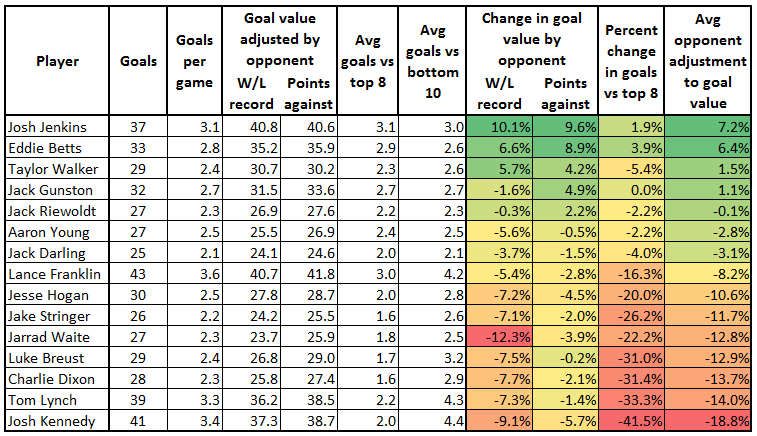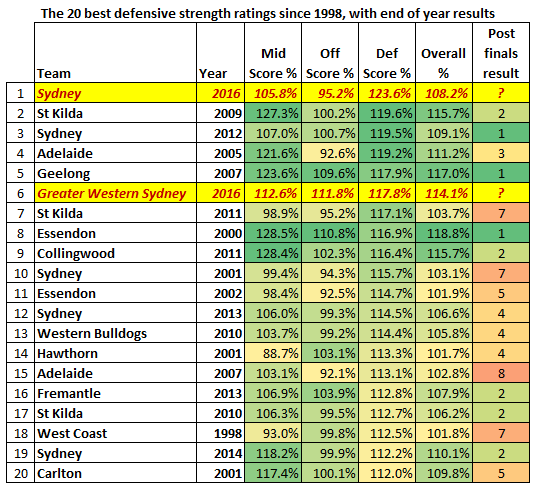Josh Jenkins is your opponent-adjusted Coleman leader
Never ones to miss a chance (justly and unjustly) to call Josh Kennedy a flat-track bully, we’ve taken a look at this season’s 15 leading goalkickers. We’ve looked at who they’ve kicked their goals against in order to see who’s really providing the most value to their teams:

The three measures we’ve made to adjust goal value are:
- Goals scaled for opponent win-loss record – this weights each goal by how far above or below 0.500 each team is. Thus a goal v North Melbourne (who are 0.833) is worth an extra 33% and a goal against Brisbane or Essendon (who are 0.083) is worth 42% less than average.
- Goals scaled for opponent points against. This adjusts each goal by how above-average or below-average each team’s defence has been this year. Thus a goal against the Bulldogs is worth 128% of average and against Brisbane is worth 73%.
- How far from their season average the player is against top 8 sides. This is also roughly half the difference between goals per game against top 8 and against bottom 10 sides (but not exactly, unless they’ve played 6 against each group).
We then averaged together the percentage changes indicated to get an all-in change to make to each player’s goal tally, giving the following “opponent adjusted Coleman” race wherein Josh Jenkins has overtaken Franklin, Kennedy and Lynch among the top 15 goalkickers, due to the opponent-rated value of his goalkicking:

Note that all three of Adelaide’s big forwards have performed better against the top sides than against weaker sides on all three of these measures. The average is for a small decline, but those guys have bucked that trend to stand up especially well in tough games.
The Crows have a bye this week but we’re keen to see if they can continue this.
Essendon are bad in kind of a weird way
As discussed in our strength ratings this week, the Bombers rate as one of the worst teams in the last decade, as far adrift of the competition as Melbourne in 2013 or the first years of GWS. Yet despite this, they have a number of statistical attributes not usually associated with truly terrible teams or with most recent wooden spoon sides. In particular, they get their share of the ball. This is a table of Essendon compared to the wooden spoon sides on a number of basic statistical differentials since 2010:

Essendon are also ranked first for marks per game and second for disposals per game, but have also conceded the most marks and most disposals.
This discrepancy between getting their share of the ball and still usually losing by a lot as their opponents get the ball, may be reflective of the Bombers having about a third or half of an AFL-standard side, quite different from the usual mess of kids and future delistees that most wooden spoon teams tend to be carrying.
These numbers suggest a cautious playstyle that is possession-heavy but breaks down due to signficiant lack of quality.
What happens to really good offensive and defensive teams?
If you’ve been reading our weekly team ratings post you’ll have seen us commenting on how historically good the Adelaide offence has been in terms of converting inside-50s to scores, and how similarly historically good Sydney have been at stopping opponents scoring from inside-50s. This raises the question about whether past teams who have been so good in these areas have been successful.
Let’s look, then, at the 20 best records in offence and defence since 1998, including the opponent-adjusted records of 2016 teams:


More really good offensive sides have won premierships than really good defensive sides – 9 premiers and three runners up populate the 18 sides in the offensive list while 3 premiers and 5 runners-up appear in the defensive list. This partly reflects that, on average, the best offensive teams rate a bit better overall. Even within this cohort, what we are seeing from Adelaide is a rare spread of traits. The Crows’ degree of forward dominance without correspondingly very high midfield strength is really only matched by the 2004 Port Adelaide side among premiers, as well as 1998 North Melbourne and 2010 Geelong and the Crows themselves in 2012.
Among top defensive sides, Geelong in 2007 and Essendon in 2000 were just extremely dominant teams, period. That means that only Sydney in 2012 appears as a premiership team whose clear biggest strength was its very defensive efficiency. There just haven’t been as many sides who have rated highly overall with defence being their biggest strength – Sydney 2012 and Adelaide 2005 are really the only two sitting in the range the 2016 Swans now sit. Other strong sides have either had better midfield strength (ie inside-50 differentials) or have been pretty evenly strong across the board.
On the other hand, while more strong offensive teams have won flags, every top 20 defensive side made finals, while several with a top 20 inside 50 offensive strength missed the finals altogether. This may illustrate that it’s easier for a mediocre side to have a good forward line than a good defence, or that a good defence lets teams grind out results without threatening in September.
GWS sitting in both lists is illustrative of why we think they’re premiership favourites right now. Their midfield is unusually lacking for a side with both their high offensive and defensive ratings, but the sheer degree of balance and quality across the measures is suggestive of a side on the cusp of something pretty special.
Things to watch this week
Max Gawn is in for a day out
Kurt Tippett is the competition’s best ruck-forward and Sydney’s number one ruck, and his injury leaves them forced to run Callum Sinclair and one of their novice big men (Toby Nankervis or Sam Naismith) against the form big man of the competition. Sydney in past seasons have done okay losing the ruck battle, especially during the Mike Pyke era, but they may find it difficult to adjust, having grown accustomed to Tippett providing them regular first use of the ball.
Moreover, just listen to how the big Demon sounds onfield. Terrifying.
With Ted Richards still missing and the underrated Jeremy Laidler out with a knee injury, Sydney also look vulnerable in defence. If the Demons are to threaten, it’ll likely be by exploiting Gawn’s dominance and moving the ball quickly before Sydney’s badly undersized defence can organise to cover each other.
GWS should beat Essendon by a hilarious amount
This is best vs worst and rain won’t save them because it’s at Etihad.
The path to victory for the Dons probably requires John Worsfold to lobby the AFL to ban the kick and also running bounces, given their difficiencies in those areas, and only allow movement via handballs. The possibility of this happening is possibly why the Dons current odds for the match are as short as 14.00.
Hot take of the week
We cast our eyes over this petulant dirge of an article bemoaning that GWS, a new football team, will have success and “nobody” will care. We hate this attidude for a number of reasons.
The first is the view that expansion sides should not have success because there’s no sad old people who remember them being bad for a long time. Let’s be straight – we at HPN are all in favour of Melbourne and the Swans winning every premiership from here to 2025 to make up for decades of suffering fandom, but that’s a terrible metric by which to judge the worth of a team or a result.
We wonder whether there was similar bitching about sides not doing a 30 year apprenticeship when West Coast, Adelaide (and even Port Adelaide) won quick premierships with a heavily reliance on the concessions they were given when they joined the AFL. There are no long suffering West Coast or Adelaide fans, those teams have never been bad for very long and will never face existential crisis. Does that invalidate them? What about all the flags won pre-equalisation by teams able to rort the transfer and zone system and poach players to maintain their dominance while other teams struggle? Should those Carlton and Essendon and Collingwood premierships all be dismissed as “manufactured”?
This attitude that some happiness by some fans is worth more than others is poisonous. If GWS win a premiership, they will make significant numbers of new fans and recent converts happy. They’ll make many people who support them happy. They’ll make people who don’t like their opponents happy. There’s no obvious reason to dismiss that happiness in comparison to that of others.
Moreover, we’d point out that ever year most of the AFL doesn’t see their team win a premiership and we still mange to enjoy the sport and keep coming back. How many people enjoy a flag because their team wins is a stupid thing to judge by. By that weird football utilitarian logic it would be desirable to hobble unpopular clubs like North Melbourne to increase total football happiness. But even when Collingwood win the flag, over 90% of AFL fans don’t get to see their side win – and you don’t see the rest of the league celebrating that a lot of fans got to see their team win. What’s the difference if a somewhat higher proportion of fans don’t get a flag the year GWS win?
Besides which, GWS’ inoffensiveness and the sheer fun of their gamestyle would likely mean that even by some ‘higher average happiness’ metric, you’d get more happy football fans with a Giants flag than Collingwood or Hawthorn winning.
The third problem is these tacky buzzwords like “manufactured” and the attitude that the club is being “handed” success. This is Bigfooty sledging level rhetoric. We’ve written about this before, but the thing with GWS is that to be as good as they look now, they’ve run a nearly flawless recruitment strategy. They nailed their initial selections and then turned every loss of a player into something useful. There was never a guarantee that would happen (we’ve seen plenty of clubs screw up despite having a bunch of early picks, after all), so let’s actually give them a little credit for building what they’ve built.

Turns out GWS -did- beat Essendon by a hilarious amount – but not in the way you predicted. Was an amazing game to watch for 3 and a half quarters.